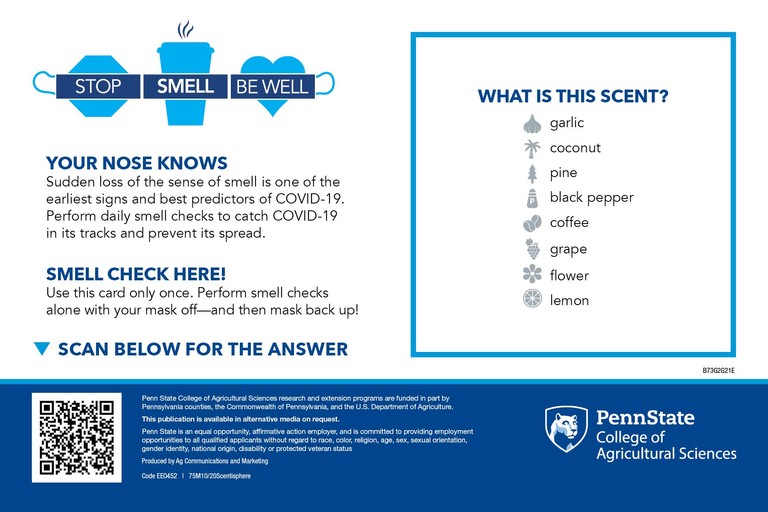IMAGE: DANA TENTIS VIA PIXABAY
UNIVERSITY PARK, Pa. — Students, faculty, staff and others visiting well-traveled areas of Penn State campuses across the state may have noticed or received postcards with a “peel-and-sniff” area prompting them to detect and identify a particular aroma. If their olfactory senses fail them, they may be infected with COVID-19.
The cards are part of a public awareness campaign spearheaded by sensory researchers in the College of Agricultural Sciences‘ food science department. The goal is to help people quickly identify possible COVID-19 infections so they can avoid potential spread of the coronavirus by isolating, seeking testing and consulting a health care provider.
Research has shown that sudden-onset anosmia, or loss of smell, is one of the most specific symptoms of COVID-19 infection, according to John Hayes, professor of food science and director of the Penn State Sensory Evaluation Center.
“Studies suggest that between half and three quarters of people with COVID-19 abruptly lose their sense of smell, sometimes in the absence of or before other symptoms,” Hayes said. “We hope these cards will encourage people to check for sudden smell loss, which should help identify otherwise asymptomatic or presymptomatic people more quickly.”
Hayes noted that the postcards are not needed to check your sense of smell. “People can simply smell their coffee, flowers, scented candles or other fragrant household items,” he said. “We developed the smell-check cards as a memorable way to share the message and remind people to perform daily smell checks.”
Hayes cautioned that an individual smell-check card is meant is to be used by only one person and never should be shared after use. Users are encouraged to peel-and-sniff the card alone, without wearing a mask, and are reminded to mask back up. After guessing the scent, users can scan a QR code on the card to reveal the aroma and learn more.
Users unable to smell the scent upon initial use are instructed to self-isolate and contact a health care professional. The cards also remind users that anosmia is just one symptom of COVID-19 and that they should monitor for all symptoms indicated by the Centers for Disease Control and Prevention.
Hayes and colleague Alyssa Bakke, staff sensory scientist in the Sensory Evaluation Center, also spearheaded the development of the “Stop. Smell. Be Well.” webpage, which urges page visitors to make smell checks part of their daily routine. The page lists other symptoms associated with COVID-19 — such as fever, dry cough, shortness of breath, aches and fatigue — provides links to other Penn State resources and points readers to related news stories. Visitors also can learn about the science behind how the virus attacks the sense of smell.
Hayes and Bakke, who holds a doctorate in food science, are members of an international research team, the Global Consortium for Chemosensory Research, that has studied the link between COVID-19 and smell loss. Collaborating with more than 600 clinicians, scientists and patient advocates in 40 countries in an ongoing study, the Penn State researchers so far have surveyed more than 50,000 participants who suffered from recent respiratory illness.
“Our results showed that of all common symptoms of COVID-19, sudden smell loss was the single best predictor of being positive for the disease,” Hayes said. “Other studies are finding similar results. Together, this suggests that sudden smell loss is a better predictor than fever or cough.”
Additional Penn State COVID-19 resources and information can be found at https://virusinfo.psu.edu/.
Source: Smell-check cards help call attention to common COVID-19 symptom | Penn State University














